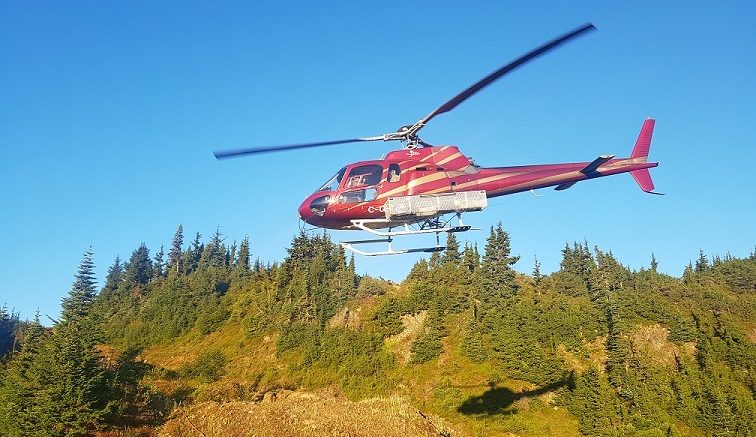Skeena Resources (TSX: SKE; US-OTC: SKREF) released an updated resource estimate for the company’s flagship Eskay Creek gold-silver project. Located in the Golden Triangle district of northwestern British Columbia Eskay Creek is a past-producing underground mine first discovered in 1988, that Skeena initially optioned from Barrick Gold (TSX: ABX; NYSE: GOLD) in 2017, before acquiring 100% ownership in October last year.
After optioning the Eskay Creek project, Skeena began a review of the asset’s potential to resume operations with a focus on an open pit mine as its primary production source.
The company’s revised estimate for pit constrained and underground resources at Eskay Creek is 38.5 million measured and indicated tonnes grading 3.1 grams gold per tonne and 82.1 grams silver per tonne, for 3.9 million oz. gold and 101.6 million oz. silver, and 5.7 million inferred tonnes grading 1.3 grams gold per tonne and 27.4 grams silver per tonne for 231,000 oz. gold and 5 million oz. silver.
The updated resource was derived from an analysis of 7,583 historical surface and underground diamond drill holes that totalled 651,332 metres, as well as the results from exploration work done by Skeena between 2018 and 2021. This exploration program saw 750 surface diamond drill holes completed, totalling 104,740 metres.
“The resource update is a huge milestone for the company,” Walter Coles, Skeena’s president and CEO, said in an interview. “The measured and indicated resources have increased by an astounding 186%, on a tonnage basis, since our last resource report.”
Coles said that the Vancouver-based company has initiated an accelerated property scale exploration program this year. The program is intended to define additional near surface, bulk tonnage mineralization in order to expand the current resource base, and to supplement the company’s existing mine plan. Drill testing of the near mine and regional targets is anticipated to commence in the second half of this year.
“We’re trying to balance two priorities from the technical perspective: On the one hand we continue to grow the resource, while also trying to maintain a tight timeline to getting this into production,” he said. “Then, on the engineering side, we’re planning to publish a prefeasibility study this summer, following that up with a full feasibility study in the December 2021 to first quarter 2022 timeframe, probably in the first quarter.”
Coles added that in between the prefeasibility and the feasibility studies, Skeena intends to initiate project finance discussions, with the idea of raising the full project financing immediately after the feasibility study is done.
According to Skeena, the former Eskay Creek mine was once the highest-grade gold mine in the world when it was in production, as well as being the fifth-largest silver operation by volume. It produced 3.3 million oz. of gold and 160 million oz. of silver at average grades of 45 grams gold per tonne and 2,224 grams silver per tonne between 1994 and 2008.
“Eskay Creek is a legendary underground mine, and we were attracted to it for three reasons,” he explained.
First, the price of gold and silver are much higher today than when Eskay Creek was shut down in the first quarter of 2008, he said. The second reason was that new hydroelectric power stations are now located close to the site, replacing the expensive diesel and propane power that was used at the mine when it operated in the 1990s-2000s. Having cheap, clean hydro power amounts to a paradigm shift in the project’s cost structure, he says. Third, Coles and his team felt that Eskay Creek had a new chance of life as an open pit operation.
“Back in the 1990s in B.C. it was considered difficult to impossible to permit an open pit mine. However, starting in the late 2000s there were a series of open pit mines permitted in the Golden Triangle. So, we came to the conclusion that it would be a viable scenario for a revitalized Eskay Creek.”
According to a preliminary economic assessment Skeena released in November 2019, a high-grade open pit would produce 306,000 oz. of gold equivalent a year over a mine life of nine years. The early stage study forecast initial capex of $303 million.
The project is located on Indigenous land, part of the Tahltan Nation, and Coles said working with the First Nation was always an important aspect of the company’s business plan in developing the project.
“We view the relationship with the Tahltan Nation as critically important,” he said. “We’ve adopted a stance that we are guests in Tahltan territory and we will only continue to work there so long as we have the support of the Tahltan Nation. Without that, you don’t have a project.”

Walter Coles, CEO and president of Skeena Resources (r.), with Chad Day, president of the Tahltan Central Government. Credit: Skeena Resources
As part of the development process, Skeena intends to complete impact benefit negotiations with the Tahltan Nation, and hopes to have that agreement in place before the end of the year.
Coles added that the company is currently involved with discussions with the Tahltan Nation and the province to nail down the permitting timeline so that they can better plan for when to begin start construction, and eventually commence production.
“I really believe we’re following industry best practices so far,” said Coles. “You can’t operate in a situation like this unless you have support of your Indigenous partners. I think we’re doing what every mining company should be doing.”
At press time, Skeena was trading at $3.60 within a 52-week range of 92¢ and $3.95. The company has 217 million common shares outstanding for a market cap of $799 million.


Be the first to comment on "Updated: Skeena releases new resource for Eskay Creek project"